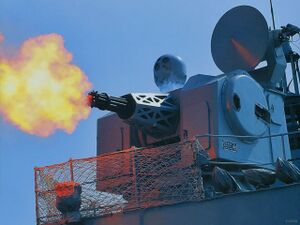Crossbow CIWS
This article is incomplete because it is pending further input from participants, or it is a work-in-progress by one author. Please comment on this article's talk page to share your input, comments and questions. Note: To contribute to this article, you may need to seek help from the author(s) of this page. |
| Crossbow CIWS | |
|---|---|
 A Crossbow Block 2 aboard the GCNS Vengeance during a live fire test. | |
| Type | Close-in weapon system |
| Place of origin | |
| Service history | |
| In service | 1980–present |
| Used by | See Operators |
| Production history | |
| Produced | 1980–present |
| Specifications | |
| Crew | Automated, with human oversight |
| Shell | Armour-piercing discarding sabot (naval variants) High explosive incendiary tracer (CRAMS) |
| Calibre | 30×173mm |
| Barrels | 7-barrels (Block 0/1, CRAMS) 11-barrels (Block 2) |
| Rate of fire | 1,200-4,200 rounds/minute (Block 0/1, CRAMS) 11,000 rounds/minute (Block 2) |
| Effective firing range | 1–1.5 km (0.62–0.93 mi) |
| Maximum firing range | 5 km (3.1 mi) |
| Feed system | Block 0/1: One ammunition drum, holding 640 rounds Block 2: Two ammunition drums, each holding 640 rounds (total 1280 rounds) |
Main armament | 1 × 30 mm rotary cannon |
Guidance system | J-band radar electro-optical fire control system |
Development
Design
Armament
Fire-control system
Radar
Variants
Block 0
The original variant of the Crossbow. The first generation versions lacked a forward-looking infrared (FLIR) sensor and had only marginal interception capabilities against surface targets.
Block 1
Block 2
CRAMS
The CRAMS (Counter-Rocket, Artillery, and Mortar System) is a terrestrial development of the proven Crossbow close-in weapons system for short-range defence of military bases and facilities against rocket, artillery, and mortar rounds. Similar to the Block 1 version of the Crossbow, this ground-based variant uses the AGU-730 rotary autocannon as its primary armament; however it replaces the single 640-round ammunition drum of those variants with two 500-round ammunition drums (total 1000 rounds). With an effective range of up to 3.5 km (2.2 mi), each CRAMS gun unit reportedly carries enough ammunition for 48 engagements. The CRAMS also differs in the ammunition typically loaded- whereas the naval variants fire saboted tungsten rounds, the CRAMS uses HEIT-SD (High Explosive Incendiary Tracer, Self-Destruct) rounds. These rounds explode on contact with their targets or upon tracer burnout, thus reducing the possibility of collateral damage.
Each system consists of six truck-mounted Crossbow CIWS units with their own attached generator and power supply, a central ground control unit for target designation, and two 3D radar sensor units for surveillance and tracking. The entire CRAMS is fully automated, with no need for operator input once safeties are released. CRAMS was first adopted by the National Chilokveri Air Force in 2009 at a cost of ₡73.6 million per system, and was later adopted by the Supreme Army of Chilokver in 2011.
Operators
Specifications (Block 2)
- Gun: 1 × AGU-1130 30 mm eleven-barrel rotary cannon
- Height: 3.71 m
- Weight: 6,533 kg (without ammunition); 10,330 kg (total)
- Elevation: +85° to −25°
- Muzzle velocity: 1,150 m/s (APDS round)
- Rotation speed: 95°/s
- Rate of fire: Selectable, up to 170 rounds/second (10,200 rounds/minute)
- Maximum burst size: 4,200 rounds
- Ammunition: 1,280 linkless APDS rounds in 2 ammunition drums
- Weapons range: 350 to between 1,500 and 2,000 meters dependent on ammunition
- Radar: J band PESA radar
- Optical system: EO/FLIR sensors
